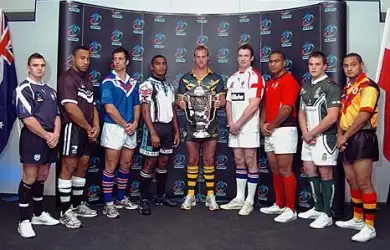World Cup needs to be uncomplicated

Rugby league has long suffered the phenomenon of overcomplicated fixture lists. Even a league season can’t be simple, as for years a 12-team Super League had six extra fixtures bolted onto the end of it. It can be a real mental challenge getting to grips with explanations of how tournaments work, with statements like “Winner Pool A plays Third-Placed from Pool 9”, and “Loser Game 6 plays Winner Group 12” often failing to enlighten.
Sometimes this is driven by necessity, such as in the qualifying tournament for the 2008 World Cup. Yet sometimes we seem to overcomplicate things for no good reason. Why is it that in years past the winners of the National League One play-offs gained promotion, yet it was the table-toppers of National League Two that did likewise? The bottom-placed team in NL1 was relegated, while the second-from-bottom team took part as the highest-ranked side in the NL2 play-offs. It made little sense; plus, when Halifax received a plate confirming they were the play-off champions of the division below they appeared to be less than thrilled.
(Wow, all that talk of promotion and relegation has left me feeling nostalgic. Anyway…)
It was a similar story for the 2008 World Cup, where there was a “Super Group” of four teams from which three teams would qualify for the semi-finals, while the fourth semi-finalist was the winner of the play-off between the winners of two further groups of three. The 2013 World Cup looks set for more of the same: with 14 teams competing it’s most likely that the “Super Group” will make its return, accompanied by two groups of five from which will be drawn a fourth semi-finalist.
Nicholas Woodward suggests an alternative structure in a very interesting article – http://www.lasttackle.com/blogpost_233-world-cup-needs-to-be-fair.html – on this site yesterday. He argues convincingly that, as with the 2008 World Cup, teams of similar ability ought to be grouped together to avoid one-sided games and generate more interest in the fixtures.
Yet, the main problem with Nicholas’ suggestion is how difficult it is to understand. The “Super Group” was retained, and beneath that another group of the next four ranked teams (a “Super Group division two”?) and beneath that two parallel groups of three. Three teams would progress from each of the top two groups and one each from the bottom two, providing eight teams to contest the quarter finals. While Nicholas makes an excellent case for why we should consider such a tournament the format is far too convoluted. It’s also unfair: why should two of the six lowest-ranked teams qualify for the quarter finals while the team ranked fourth will have to compete with England, Australia and New Zealand, and will almost certainly miss out?
So what would be a better format? I think we should have a 12-team World Cup, with four groups of three, the winners of each group progressing to the semi finals. England, Australia and New Zealand would be seeded into separate groups. This would not be the disaster many imagine: the clarity and ease of understanding offered by this format can only be a good thing. Added to that, such a short group stage will not dent the interest that will be generated prior to the tournament; within a fortnight of the opening ceremony we’ll be seeing the top four teams playing each other in the semi finals.
Rugby league is far more concerned about how one-sided games look than any other sport. For instance, the group stage of the 2007 Rugby [Union] World Cup saw Australia beat Japan 91-3, and New Zealand beat Romania and Portugal 85-8 and 108-13. This is because rugby league suffers a credibility gap which other sports don’t suffer. However, perhaps we would have more credibility simply allowing Australia to put sixty points on Scotland rather than going through bizarre contortions to ensure they never meet.
Keep Your Eye on Rugby League